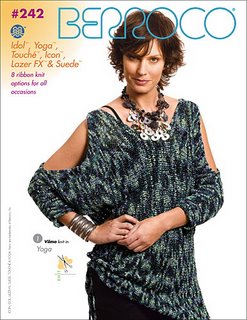Tuesday, February 28, 2006
Something to ponder
If you are lactose-intolerant, will knitting with swallow casein needles give you diarrhea?
Monday, February 27, 2006
Prepare to be gobsmacked (or another customer horror story)
What if you were working at a yarn shop and a customer used her cell phone to take a photograph of a pattern, so she wouldn't have to buy the whole book? A reader sent me links to the photographer -- actually, the photographer's mother, as I believe the deed was done by her teenaged daughter -- and another blogger who called her out on it. The photographer's response? Well, she was out of money and ree-e-eally wanted the pattern, and since she wasn't "profiting" from using the pattern (according to her own peculiar definition of "profit," which apparently doesn't encompass the notion that she saved thirty bucks by not buying the book, thereby profiting to the tune of -- yep -- thirty bucks), she isn't violating copyright. In my humble opinion, she's dead wrong on that (which is why if you want a valid interpretation of U.S. copyright law, you shouldn't ask a sixteen-year-old who never went to law school and "dislikes unnecessary research"). Stealing is stealing. Last time I checked, it didn't matter if the thief really really wanted the item, or already spent all her money on something else: if you take something without paying for it, and without the consent of the owner, you're stealing.
The photographer and her mama apparently live in the Pacific Northwest, so if you own a yarn shop in that corner of the U.S., you might want to keep your eye out for any sixteen-year-olds whipping out cell phones while browsing at patterns in your shop.
Anybody who tries that at Rosie's on my watch? I'll rip 'em a new one.
And then I'll call the cops.
Thanks to reader J., for the tip and the links.
The photographer and her mama apparently live in the Pacific Northwest, so if you own a yarn shop in that corner of the U.S., you might want to keep your eye out for any sixteen-year-olds whipping out cell phones while browsing at patterns in your shop.
Anybody who tries that at Rosie's on my watch? I'll rip 'em a new one.
And then I'll call the cops.
Thanks to reader J., for the tip and the links.
Sunday, February 26, 2006
Customer service
Yesterday I had an encounter with an unpleasant customer. It was one of those situations when someone comes into the shop spoiling for a fight, and I just happened to be the first person who crossed her path. I did my best to refuse to participate in the Snit-a-palooza, at one point excusing myself to go (allegedly) to the ladies' room so I wouldn't garrotte her with a loose pair of Addi Turbos. (I mean, is it my personal fault that the shop sold out of size 9 bamboo needles in a 14-inch length? Does the lack of a particular knitting needle that you desire -- although we did have perfectly nice 10-inch and circular needles in that size and virtually every other size known to humankind -- entitle you to berate me because "needles, they're kind of like staples for a yarn shop, wouldn't you say?")
I knew that this customer's disgruntlement didn't have anything to do with me, really, but it did get me thinking again about customer service and the yarn shop. This is another topic about which I don't have any clear answers, just a lot of questions, most of them revolving around the dilemma of just how much customer service it is reasonable to expect from your local yarn shop. When does helping a customer morph into letting someone take advantage of you? How and where do you draw the line?
Generally, my attitude, and that of my co-workers, is extremely pro-customer. We will help you pick a pattern, we will help you pick a suitable yarn, we will tailor classes to your needs, we will explain gauge, we'll stop whatever else we're doing to help you, we will teach you discrete new skills, we will do knitting 9-1-1 and fix mistakes, we will give you free tips and advice, we will help you pick colors, we will let you use the bathroom, we won't rush you out the door if it takes a long time to decide, we will special-order, we will look up nearby lunch places for you if you're from out-of-town, and so on. In other words, we will try to help a customer in whatever way we can. I want to immediately qualify that as "in whatever way we can, within reason" because it seems to me that more and more, lately, we've been getting customers who make unreasonable demands.
Every yarn shop has the customer who really, really wants to make a pattern from a pattern book but balks at buying the whole book. "Do I have to buy the whole book just to make one pattern?" they whine. In a word, yes. I will not make photocopies of a book to allow a customer to make a pattern and avoid compensating the designer for the work put into making it. Apart from being shitty, it's illegal. In fact, we don't even have a copy machine at Rosie's, thus providing a very convenient dodge for particularly persistent copyright-flouters. From a customer's standpoint, well, yes, it is unfortunate that you don't want any other pattern in the book, but tough. Take it up with the U.S. Congress, the federal copyright bar and the knitting designer's trade union.* And consider whether it's fair of you to ask an employee of your LYS to violate the law for you in order to get something for nothing.
That's an easy case. The request is illegal, so no dice. But what about a customer who asks you to rewrite an entire pattern for a different gauge? This is one of those grey areas that makes me cringe. If it's a really easy thing, like adding or subtracting some stitches to or from a scarf pattern -- there's no shaping, and there's no real issue of "fit" as there would be in a sweater -- I'm happy to fiddle with it. But is it fair to expect a yarn shop employee to sit down with a calculator and a notepad, and essentially re-design a sweater? What about a garment that's more involved than a scarf but less involved than a sweater? Some will say that "at such and such a shop in New York, they'll write a pattern for you in whatever size you want and whatever gauge you want whenever you buy yarn." Hmmm. I'm not sure I believe you, but maybe they have pattern-generating software in the back, because that seems like an awful lot of work to be giving away for free.
And what happens if you don't like the way the free pattern knits up? Some might say you get what you pay for and if the pattern is free, well, maybe you shouldn't complain. Then again, that would be a reasonable attitude, and we're talking about the unreasonable minority here. All too many times I've had knitters come back to bite me in the butt. They ask me to rejigger the numbers on a pattern to accommodate a particular yarn they want to use, and no matter how the lawyer in me qualifies my work ("This is going to look very different from the sample because you're using a bulky thick-and-thin wool that has pieces of dryer lint sticking out of it, and the sample is a fingering-weight mercerized cotton") they return in a few days or weeks, project in tow, complaining that the dreaded "Someone who works here" gave them an iron-clad guarantee it would look just dandy in dryer lint.
What about asking a yarn shop employee to teach you to knit? We do occasionally have someone walk in off the street who wants to buy needles and yarn, sit down and have us show them how to knit. From scratch. This is another one of those oogey situations. Some people learned a long time ago and forgot, or pick it up really quickly, so it's just a matter of showing them the knit stitch once and they've got it. Others, however, are what we could euphemistically call "slow learners" and require much hand holding, thereby resulting in much hand-wringing. Is it fair to expect a LYS employee to ignore other customers for a prolonged period of time to walk you through the basics of knitting for free? We offer beginner's classes, we have knitting circle which is a time when many gonzo knitters are sitting around who'd love to share their craft with you, and we offer private lessons; ought you to expect a yarn shop employee to teach you gratis? Would you walk into Barnes and Noble and ask one of their employees to teach you to read? Does it matter if you buy, on the spot, yarn and needles and maybe a how-to-knit book, or if you bring your own yarn and needles? Put another way, how would you feel about walking into Home Depot with lumber, hammer and nails you bought at Lowe's and asking them to teach you how to make a bookcase?
Pretty much every shift I work, a determined-looking customer walks in with a stuffed project bag. "Can I help you with something?" I cheerfully ask. "Yes," the customer says decisively. "I have a few questions about the project I'm working on." The "Great!" dies on my lips as the knitter pulls out yarn and needles and patterns that weren't purchased from our shop. Sometimes 2 or 3 different projects, none of which were purchased at our shop. The question might be simple, like how do I do a three-needle bind-off? or what does "YO" mean? But all too often, it's complex. "I think there's a mistake in this pattern," the knitter says -- and it's what we call a "house pattern" -- one created by the owner or staff of the yarn shop to go with a yarn purchase -- from a different yarn shop. Is it fair to expect to walk into a shop with items you bought somewhere else and ask for help with them? Could you walk into the Dell Computer store with an Apple laptop and expect them to show you how it works or fix it if it breaks? Even if you could, would you?
I'm going to tell you a shocking truth about yarn shops: it's hard to make money owning them. The competition is fierce and the profit margin is low. Think about how many new yarn shops have opened up on-line and on the street, and how price competition from gigunda retailers (A.C.Moore, KnitPicks) has provided knitters with additional choices. One of the ways that bricks-and-mortar yarn shops can distinguish themselves from the Internet competition, and from the bricks-and-mortar competition, is by providing stellar customer service. That's fine; under normal circumstances, we're happy to do it. Some people, however, are inclined to take advantage of that. The quid pro quo for getting good customer service is buying something regularly at that shop. Your local yarn shop isn't a library, subsidized by the public to provide free services; it's a business. The next time you take six hanks of yarn you bought on E-bay to your LYS to use their ball-winder, think about that.
*No, there isn't really a knitting designer's trade union. But you get the point, don't you?
I knew that this customer's disgruntlement didn't have anything to do with me, really, but it did get me thinking again about customer service and the yarn shop. This is another topic about which I don't have any clear answers, just a lot of questions, most of them revolving around the dilemma of just how much customer service it is reasonable to expect from your local yarn shop. When does helping a customer morph into letting someone take advantage of you? How and where do you draw the line?
Generally, my attitude, and that of my co-workers, is extremely pro-customer. We will help you pick a pattern, we will help you pick a suitable yarn, we will tailor classes to your needs, we will explain gauge, we'll stop whatever else we're doing to help you, we will teach you discrete new skills, we will do knitting 9-1-1 and fix mistakes, we will give you free tips and advice, we will help you pick colors, we will let you use the bathroom, we won't rush you out the door if it takes a long time to decide, we will special-order, we will look up nearby lunch places for you if you're from out-of-town, and so on. In other words, we will try to help a customer in whatever way we can. I want to immediately qualify that as "in whatever way we can, within reason" because it seems to me that more and more, lately, we've been getting customers who make unreasonable demands.
Every yarn shop has the customer who really, really wants to make a pattern from a pattern book but balks at buying the whole book. "Do I have to buy the whole book just to make one pattern?" they whine. In a word, yes. I will not make photocopies of a book to allow a customer to make a pattern and avoid compensating the designer for the work put into making it. Apart from being shitty, it's illegal. In fact, we don't even have a copy machine at Rosie's, thus providing a very convenient dodge for particularly persistent copyright-flouters. From a customer's standpoint, well, yes, it is unfortunate that you don't want any other pattern in the book, but tough. Take it up with the U.S. Congress, the federal copyright bar and the knitting designer's trade union.* And consider whether it's fair of you to ask an employee of your LYS to violate the law for you in order to get something for nothing.
That's an easy case. The request is illegal, so no dice. But what about a customer who asks you to rewrite an entire pattern for a different gauge? This is one of those grey areas that makes me cringe. If it's a really easy thing, like adding or subtracting some stitches to or from a scarf pattern -- there's no shaping, and there's no real issue of "fit" as there would be in a sweater -- I'm happy to fiddle with it. But is it fair to expect a yarn shop employee to sit down with a calculator and a notepad, and essentially re-design a sweater? What about a garment that's more involved than a scarf but less involved than a sweater? Some will say that "at such and such a shop in New York, they'll write a pattern for you in whatever size you want and whatever gauge you want whenever you buy yarn." Hmmm. I'm not sure I believe you, but maybe they have pattern-generating software in the back, because that seems like an awful lot of work to be giving away for free.
And what happens if you don't like the way the free pattern knits up? Some might say you get what you pay for and if the pattern is free, well, maybe you shouldn't complain. Then again, that would be a reasonable attitude, and we're talking about the unreasonable minority here. All too many times I've had knitters come back to bite me in the butt. They ask me to rejigger the numbers on a pattern to accommodate a particular yarn they want to use, and no matter how the lawyer in me qualifies my work ("This is going to look very different from the sample because you're using a bulky thick-and-thin wool that has pieces of dryer lint sticking out of it, and the sample is a fingering-weight mercerized cotton") they return in a few days or weeks, project in tow, complaining that the dreaded "Someone who works here" gave them an iron-clad guarantee it would look just dandy in dryer lint.
What about asking a yarn shop employee to teach you to knit? We do occasionally have someone walk in off the street who wants to buy needles and yarn, sit down and have us show them how to knit. From scratch. This is another one of those oogey situations. Some people learned a long time ago and forgot, or pick it up really quickly, so it's just a matter of showing them the knit stitch once and they've got it. Others, however, are what we could euphemistically call "slow learners" and require much hand holding, thereby resulting in much hand-wringing. Is it fair to expect a LYS employee to ignore other customers for a prolonged period of time to walk you through the basics of knitting for free? We offer beginner's classes, we have knitting circle which is a time when many gonzo knitters are sitting around who'd love to share their craft with you, and we offer private lessons; ought you to expect a yarn shop employee to teach you gratis? Would you walk into Barnes and Noble and ask one of their employees to teach you to read? Does it matter if you buy, on the spot, yarn and needles and maybe a how-to-knit book, or if you bring your own yarn and needles? Put another way, how would you feel about walking into Home Depot with lumber, hammer and nails you bought at Lowe's and asking them to teach you how to make a bookcase?
Pretty much every shift I work, a determined-looking customer walks in with a stuffed project bag. "Can I help you with something?" I cheerfully ask. "Yes," the customer says decisively. "I have a few questions about the project I'm working on." The "Great!" dies on my lips as the knitter pulls out yarn and needles and patterns that weren't purchased from our shop. Sometimes 2 or 3 different projects, none of which were purchased at our shop. The question might be simple, like how do I do a three-needle bind-off? or what does "YO" mean? But all too often, it's complex. "I think there's a mistake in this pattern," the knitter says -- and it's what we call a "house pattern" -- one created by the owner or staff of the yarn shop to go with a yarn purchase -- from a different yarn shop. Is it fair to expect to walk into a shop with items you bought somewhere else and ask for help with them? Could you walk into the Dell Computer store with an Apple laptop and expect them to show you how it works or fix it if it breaks? Even if you could, would you?
I'm going to tell you a shocking truth about yarn shops: it's hard to make money owning them. The competition is fierce and the profit margin is low. Think about how many new yarn shops have opened up on-line and on the street, and how price competition from gigunda retailers (A.C.Moore, KnitPicks) has provided knitters with additional choices. One of the ways that bricks-and-mortar yarn shops can distinguish themselves from the Internet competition, and from the bricks-and-mortar competition, is by providing stellar customer service. That's fine; under normal circumstances, we're happy to do it. Some people, however, are inclined to take advantage of that. The quid pro quo for getting good customer service is buying something regularly at that shop. Your local yarn shop isn't a library, subsidized by the public to provide free services; it's a business. The next time you take six hanks of yarn you bought on E-bay to your LYS to use their ball-winder, think about that.
*No, there isn't really a knitting designer's trade union. But you get the point, don't you?
Friday, February 24, 2006
If at first you don't succeed, ply, ply again
In the comments to my last post, Evelyn kindly asked me to share any thoughts I had about newbie spinning. Asking me to opine about spinning is a bit like asking George W. Bush about planning foreign policy: I don't do it often and I don't do it well. But like Dubya, I never balk at shooting my mouth off about something I have only a superficial knowledge of, so here goes.
My tips for newbie spinning can be summarized in three paragraphs.
1. Pick the right kind of fiber to start with. It is possible to teach yourself to spin with any kind of fiber, including really slippery or short-fibered ones, but it will be more difficult and more frustrating. I threw myself on the mercy of some kind internet vendors and asked them for their advice about good fibers for newbies. The Colonial top I've been using is a good choice, as is anything with longer fibers. Non-wool fibers have their own idiosyncrasies and so I stuck to plain wool (as opposed to, say, a wool/mohair blend). The Woodland Woolworks spinning catalog very helpfully classifies fibers by the length of their staple, so you can stick to the long- and medium- ones and make it easier on yourself. Their catalog also contains helpful notations like "good for beginners" to make it even easier to select some wools that will be easier to learn on.
2. Prepare the fiber before you try to spin it. The best thing I learned in my drop spindle class was to predraft the fiber. Whether your fiber comes in little balls (roving) or sheets (top), pull off a smaller piece and very gently grasp it at both ends. Tug oh-so-slightly, increasing the tug only until you feel the fibers start to slip apart, lengthening the piece. (But don't pull too hard, or the piece will pull in half, which isn't helpful.) Then pull each piece into skinny strips, about the width of a Chibi case. Use these to spin with.
3. Ply. I love plying. You fill one bobbin with spun yarn, then you fill another one, and then you put the full bobbins on the bobbin holder (a.k.a. "lazy kate") and thread them together thru the hole (a.k.a. "orifice") with the wire thing-y and spin them together and watch as they miraculously twist around each other and make cool-looking yarn. Apart from how much fun it is, the plying helps even out the thick- and thinness of your yarn, giving you a more consistent yarn to knit with. Sure, it's twice as thick, but for me, it's well worth it to end up with yarn that won't vary excessively in thickness and won't snap off and break midstitch. If you want to get really fancy, you can try plying with two different colors, and see the funky barberpole striping you get. Or if you use multi-colored rovings, each ply will change colors and you will be able to see all the different combinations of colors as the two strands twist around each other.
That's all I know about spinning. Wanna invade Iraq now?
My tips for newbie spinning can be summarized in three paragraphs.
1. Pick the right kind of fiber to start with. It is possible to teach yourself to spin with any kind of fiber, including really slippery or short-fibered ones, but it will be more difficult and more frustrating. I threw myself on the mercy of some kind internet vendors and asked them for their advice about good fibers for newbies. The Colonial top I've been using is a good choice, as is anything with longer fibers. Non-wool fibers have their own idiosyncrasies and so I stuck to plain wool (as opposed to, say, a wool/mohair blend). The Woodland Woolworks spinning catalog very helpfully classifies fibers by the length of their staple, so you can stick to the long- and medium- ones and make it easier on yourself. Their catalog also contains helpful notations like "good for beginners" to make it even easier to select some wools that will be easier to learn on.
2. Prepare the fiber before you try to spin it. The best thing I learned in my drop spindle class was to predraft the fiber. Whether your fiber comes in little balls (roving) or sheets (top), pull off a smaller piece and very gently grasp it at both ends. Tug oh-so-slightly, increasing the tug only until you feel the fibers start to slip apart, lengthening the piece. (But don't pull too hard, or the piece will pull in half, which isn't helpful.) Then pull each piece into skinny strips, about the width of a Chibi case. Use these to spin with.
3. Ply. I love plying. You fill one bobbin with spun yarn, then you fill another one, and then you put the full bobbins on the bobbin holder (a.k.a. "lazy kate") and thread them together thru the hole (a.k.a. "orifice") with the wire thing-y and spin them together and watch as they miraculously twist around each other and make cool-looking yarn. Apart from how much fun it is, the plying helps even out the thick- and thinness of your yarn, giving you a more consistent yarn to knit with. Sure, it's twice as thick, but for me, it's well worth it to end up with yarn that won't vary excessively in thickness and won't snap off and break midstitch. If you want to get really fancy, you can try plying with two different colors, and see the funky barberpole striping you get. Or if you use multi-colored rovings, each ply will change colors and you will be able to see all the different combinations of colors as the two strands twist around each other.
That's all I know about spinning. Wanna invade Iraq now?
Thursday, February 23, 2006
Various and sundry
Cotton yarns
Somebody whose name begins with an "M" -- Maggie? Meghan? I'm sorry, but I can't find the comment now -- asked about a worsted-weight, machine-washable, matte cotton. The best option I can think of is Rowan Handknit DK Cotton (which I've always thought is a stupid name since the yarn knits squarely at worsted weight and I've never seen a Rowan pattern knitting it at 5.5 to the inch). I've used Rowan Cotton for kid sweaters and blankets, and always been very pleased with it. I launder it in the machine on cold and dry flat. Debbie Bliss has a similar version of it if the colors don't suit. If you can hold out a few months, and heavy worsted doesn't bother you (i.e. 4.5 sts to the inch instead of 5), Mission Falls is returning with their cotton (and their wool, too). Apparently they found a new mill and are resuming production. K1C2 has Cotonade, which is very much like Mission Falls cotton; listed as heavy worsted, but I think you could get 5 to an inch with it it, and I think it's machine washable. Last, scroll further down if you don't mind self-striping; I'm knitting with a matte worsted-weight cotton but it self-stripes in bright colors, so it may not be suitable for what you're planning to knit.
Spinning
Apparently, Saturday is "Teach Someone To Spin" Day. (I have no idea who decided this, and I doubt it was Congress, but what the hay.) Coincidentally, this week my oldest kid asked me to teach him to spin on a drop spindle. Realize that this is a joke, to some extent, because I drop-spindled for about a day before realizing I really wanted to spin on a wheel. I set him up with some roving and a drop spindle. Lo and behold:
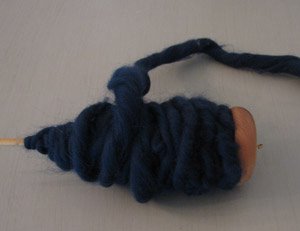
Now where did I put that set of US# 47 needles?
In the meantime, inspired by Marilyn's beautiful spinning -- and her cogent time management advice -- I decided to blow the dust off my wheel and try to spin a little bit each day. I found a bag of some kind of roving (I'm guessing it's some of that Colonial top that is sold at various spinning places and on Ebay) and began spinning away. I've been a start and stop spinner for a while now -- I start for a few months, then I stop for a few -- and it's interesting to me that when I go back to it, it seems easier and easier each time to get up to speed. I've got a bobbin full of this lovely red Colonial
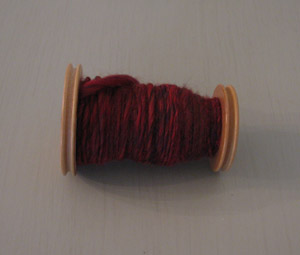
and when I fill the second bobbin, I'll ply it.
Marilyn joked that I was a "stealth" spinner since I haven't blogged about it. This is mainly because I hadn't been spinning much lately. For what it's worth, I have an Ashford Traveller wheel, which I bought about three years ago. I can understand why really good spinners like Loopy think it's a very basic wheel -- it is -- but the price was right and it is so easy to spin on. Quite nice and understanding for a first wheel. (See how I'm already acknowledging there'll be a second wheel somewhere in my future?) I also confess to being reluctant to show my early spinning efforts. I'm sure my technique is crappy and I know my yarn is lumpy, but there is something unbelievably relaxing about spinning, so I'm going to swallow my pride and post about it anyway. In fact, spinning on a wheel would be just the thing to de-stress an extremely talented, photographer/knitter/writer/artist, sheep-loving Harvard grad who works in Chicago and hates his job.
On the needles
You may notice I blog a bit less about some of the projects I'm working on than many other knit-bloggers. Sometimes it's because I have fantasies that my projects will get accepted for publication and most places frown on projects that have been shown in public before, even in progress on blogs. Right now, however, I'm working on two projects for RosieKnits, the Rosie's Yarn Cellar in-house line of patterns.
One is a kid's spring sweater in Katia Jamaica yarn. This is a worsted-weight, matte cotton that self-stripes. Here's what it looks like so far.
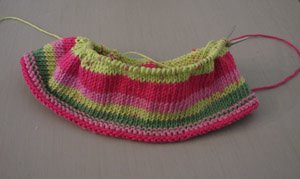
The other is Classic Elite Premiere, a blend of pima cotton and tencel (tencel is one of those man-made natural fibers, as I call them: it's from a natural substance, a plant fiber, but it's created through a manufacturing process that involves extrusion). It's delightfully soft and the robin's egg blue I'm using is lovely. I can't get a good photo of this, but I'll keep trying.
Somebody whose name begins with an "M" -- Maggie? Meghan? I'm sorry, but I can't find the comment now -- asked about a worsted-weight, machine-washable, matte cotton. The best option I can think of is Rowan Handknit DK Cotton (which I've always thought is a stupid name since the yarn knits squarely at worsted weight and I've never seen a Rowan pattern knitting it at 5.5 to the inch). I've used Rowan Cotton for kid sweaters and blankets, and always been very pleased with it. I launder it in the machine on cold and dry flat. Debbie Bliss has a similar version of it if the colors don't suit. If you can hold out a few months, and heavy worsted doesn't bother you (i.e. 4.5 sts to the inch instead of 5), Mission Falls is returning with their cotton (and their wool, too). Apparently they found a new mill and are resuming production. K1C2 has Cotonade, which is very much like Mission Falls cotton; listed as heavy worsted, but I think you could get 5 to an inch with it it, and I think it's machine washable. Last, scroll further down if you don't mind self-striping; I'm knitting with a matte worsted-weight cotton but it self-stripes in bright colors, so it may not be suitable for what you're planning to knit.
Spinning
Apparently, Saturday is "Teach Someone To Spin" Day. (I have no idea who decided this, and I doubt it was Congress, but what the hay.) Coincidentally, this week my oldest kid asked me to teach him to spin on a drop spindle. Realize that this is a joke, to some extent, because I drop-spindled for about a day before realizing I really wanted to spin on a wheel. I set him up with some roving and a drop spindle. Lo and behold:

Now where did I put that set of US# 47 needles?
In the meantime, inspired by Marilyn's beautiful spinning -- and her cogent time management advice -- I decided to blow the dust off my wheel and try to spin a little bit each day. I found a bag of some kind of roving (I'm guessing it's some of that Colonial top that is sold at various spinning places and on Ebay) and began spinning away. I've been a start and stop spinner for a while now -- I start for a few months, then I stop for a few -- and it's interesting to me that when I go back to it, it seems easier and easier each time to get up to speed. I've got a bobbin full of this lovely red Colonial

and when I fill the second bobbin, I'll ply it.
Marilyn joked that I was a "stealth" spinner since I haven't blogged about it. This is mainly because I hadn't been spinning much lately. For what it's worth, I have an Ashford Traveller wheel, which I bought about three years ago. I can understand why really good spinners like Loopy think it's a very basic wheel -- it is -- but the price was right and it is so easy to spin on. Quite nice and understanding for a first wheel. (See how I'm already acknowledging there'll be a second wheel somewhere in my future?) I also confess to being reluctant to show my early spinning efforts. I'm sure my technique is crappy and I know my yarn is lumpy, but there is something unbelievably relaxing about spinning, so I'm going to swallow my pride and post about it anyway. In fact, spinning on a wheel would be just the thing to de-stress an extremely talented, photographer/knitter/writer/artist, sheep-loving Harvard grad who works in Chicago and hates his job.
On the needles
You may notice I blog a bit less about some of the projects I'm working on than many other knit-bloggers. Sometimes it's because I have fantasies that my projects will get accepted for publication and most places frown on projects that have been shown in public before, even in progress on blogs. Right now, however, I'm working on two projects for RosieKnits, the Rosie's Yarn Cellar in-house line of patterns.
One is a kid's spring sweater in Katia Jamaica yarn. This is a worsted-weight, matte cotton that self-stripes. Here's what it looks like so far.

The other is Classic Elite Premiere, a blend of pima cotton and tencel (tencel is one of those man-made natural fibers, as I call them: it's from a natural substance, a plant fiber, but it's created through a manufacturing process that involves extrusion). It's delightfully soft and the robin's egg blue I'm using is lovely. I can't get a good photo of this, but I'll keep trying.
Monday, February 20, 2006
The big little picture
Today, I am going to talk about schematics, the little line drawing that, in the best of worlds, accompanies your knitting pattern. (For all of you experienced knitters, I apologize if this bores you. You can always entertain yourself by nitpicking my grammar. I split an infinitive or two just for you.) One of the things that will help you take your knitting to the next level is understanding and using the schematic. Think of your knitting project as a car trip: you wouldn't want to leave without a map if you're going to an unfamiliar place (or at least I wouldn't), and even if you've been given written directions, sometimes a map that shows your destination can help you arrive without getting lost and having to turn around.
One common piece of advice to newer knitters is to carefully read the pattern, beginning to end, before you cast on a single stitch. It would be wonderful if you did this to familiarize yourself with it and to anticipate possible trouble areas, but I have the feeling that most of you will blow that off. Okay, I'll face reality. But please, please, don't blow off looking at the little line drawing of whatever you're making. A good schematic will show all major parts of the garment (for a sweater, for example, you'd want to see a sleeve, and the body), along with measurements.
Here's an example of one from Rowan's book A Season's Tale:
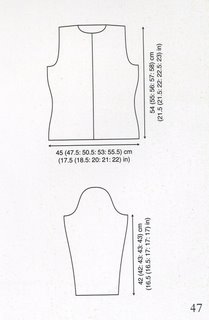
This drawing includes a sleeve (both are the same so you need only one drawing, right?) -- shown on the bottom -- and the front and back combined (the front and back are going to be mirror images, so they are usually combined into one drawing, with the front and back necklines shown. Unless you're a hunchback, in which case you ought to proceed to the seminar on Intermediate Short-Row Shaping... but that's another post for another day.) This is a cardigan, and they've indicated the divide between the left and the right fronts by the vertical line going down the middle.
You may have heard me complain in my book reviews about pattern books that don't contain schematics. It would indeed be nice if every pattern in the world came with one (unless it's a rectangle, like a scarf). Sadly, not all do. Don't worry; I'll talk about this later. Just stay with me for now.
Next I want you to take a good, common-sense look at the drawing. Let's start with the body of the sweater (you know, the front & back). How are you going to knit this sucker? From the bottom up to the top? From the top down to the bottom? From one side to another (not common, but it could happen)? Take your finger and put it on the place where you'll start. Trace your finger back and forth, the way you'll go when you're knitting. Follow your finger as it proceeds, applying your common sense to what has to happen to make your knitting match the drawing.

I've shown in red the way you will start at the bottom right-hand corner of the front (assuming you're knitting from bottom up to top) and how you will knit across one row, right to left, and then purl back, left to right.
There are really only a handful of options when it comes to what happens next. You can continue working the same number of stitches, and your garment will stay the same width. You can add stitches (increase), and it'll get wider. You can take away stitches (decrease), and it'll get smaller. Watch how this applies to my Rowan example.
You start out by going back and forth for a while without adding or taking away stitches.

Now we see the body curve in; this is shaping for the waist, i.e., the sweater starts to nip in to follow the natural line of your waist as it nips in (at least in theory; I'm taking the Fifth when it comes to my waist). The body of the sweater gets narrower, so you're going to make some decreases. Your waist nips in about equally on both sides, so you'll make equal decreases on both sides.
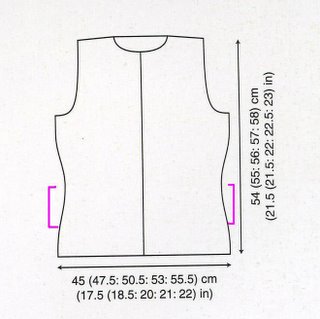
You hit the narrowest point, and the sweater starts to curve out again. So you make some increases to make the sweater wider. Again, your waist is symmetrical, so you'll make equal increases on both sides.
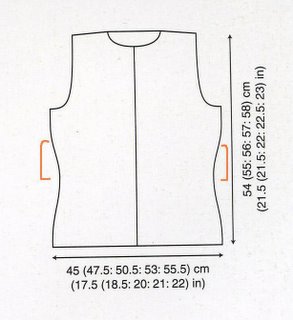
You continue without increasing or decreasing for a while, and then you hit the pit.

The armpit, or rather, the armhole shaping. You can see how the body of the sweater swoops in, making a curve that the sleeve will fit into. And follow your finger: you'll have to do it on both sides, because you have two arms. Keep applying your common sense (I know you have it, I just know you do) and you'll notice how the armhole make a sudden cut in, where you decrease a bunch of stitches at once -- in the same row -- for the flat part of the armhole (red),
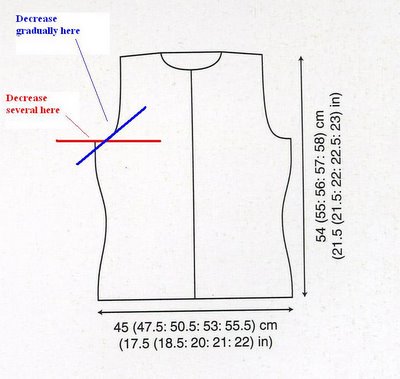
and then a more gradual slope, where you decrease one stitch per row for the upward slant (blue). Think about the way an armhole on a tank top looks and you can visualize this.
At some point, you'll have to do neck shaping. You can see on this drawing how there's a semicircle at the top, the hole that your heads goes through. To make this, you'll have to get rid of stitches. If you trace your finger back and forth, you may be able to see how you'll get rid of several stitches in the middle, all at once, to make the wide bottom part of the neck

then gradually decrease on each side, maybe one or two stitches at a time, to get the more gradual curve of the neck.
Similarly, you can take a look at the sleeve. You'll probably start at the wrist, the narrowest part, and work your way up. See how the sleeve gradually gets wider as you go up? Increases, symmetrically on the sides.
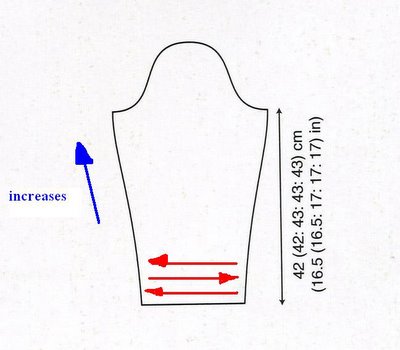
Then you can see how the sleeve dips into for the armhole, just as the body of the sweater did. They need to be mirror images of each other so you can sew them to each other. You can follow the line of the sleeve as it then decreases more gradually up to the top.
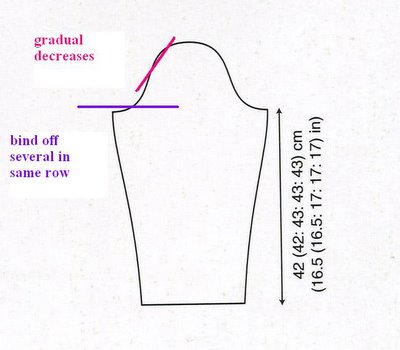
Once you begin the actual knitting, remember your little tour of the schematic. You can figure out where you are in the knitting by tracing along with your finger, and you can even anticipate the kinds of things that need to happen next. You'll be knitting along for a while, and then the pattern will tell you to decrease. "Yes," you'll mutter to yourself, "this is where the body of the sweater nips in to create waist shaping!" When the pattern tells you to increase, you'll say, "Ah, now we are adding stitches as we finish the waist shaping!" When the pattern tells you to bind off 10 stitches at the beginning of the next two rows, you'll know that first you are going to get rid of 10 stitches on one side for one armhole, and then on the next row, you are going to rid of another ten stitches on the other side for the other armhole. The pattern will make more sense to you (I hope) and you may even be able to interpret what the designer means if the pattern text itself isn't entirely clear.
If by chance your pattern does not include a drawing, don't despair. I am going to suggest something wild and radical: make your own. Get a piece of blank paper (an extra sheet of printer paper will do just fine) and a pencil. You ought to have some sense of what the garment looks like or you wouldn't have chosen to make it, right? There almost certainly is a photograph of a finished version of the item, right? You can read the pattern and figure out what they want you to do, right? (If you have no idea what you're making or what it looks like, well, then you really have no business making it, do you?)
Let me hear no whining about how you can't draw or you're a lousy artist. Ptui. [Edited for Michelene.] No one but you is going to look at this, so shut up and draw. If you were making a simple crewneck sweater, your drawing might look like this:
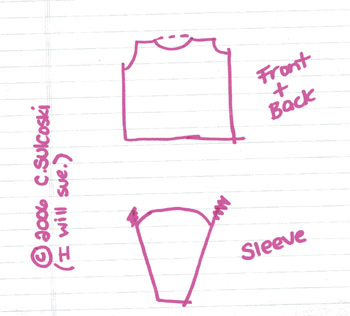
(See? I can't draw like Franklin either.) You can read through the pattern to see if there's waist shaping, what kind of armhole shaping you need, what kind of neckline is involved. And by the time you're done with the sketch, you'll have a pretty clear idea of where you're going with this sweater.
One common piece of advice to newer knitters is to carefully read the pattern, beginning to end, before you cast on a single stitch. It would be wonderful if you did this to familiarize yourself with it and to anticipate possible trouble areas, but I have the feeling that most of you will blow that off. Okay, I'll face reality. But please, please, don't blow off looking at the little line drawing of whatever you're making. A good schematic will show all major parts of the garment (for a sweater, for example, you'd want to see a sleeve, and the body), along with measurements.
Here's an example of one from Rowan's book A Season's Tale:

This drawing includes a sleeve (both are the same so you need only one drawing, right?) -- shown on the bottom -- and the front and back combined (the front and back are going to be mirror images, so they are usually combined into one drawing, with the front and back necklines shown. Unless you're a hunchback, in which case you ought to proceed to the seminar on Intermediate Short-Row Shaping... but that's another post for another day.) This is a cardigan, and they've indicated the divide between the left and the right fronts by the vertical line going down the middle.
You may have heard me complain in my book reviews about pattern books that don't contain schematics. It would indeed be nice if every pattern in the world came with one (unless it's a rectangle, like a scarf). Sadly, not all do. Don't worry; I'll talk about this later. Just stay with me for now.
Next I want you to take a good, common-sense look at the drawing. Let's start with the body of the sweater (you know, the front & back). How are you going to knit this sucker? From the bottom up to the top? From the top down to the bottom? From one side to another (not common, but it could happen)? Take your finger and put it on the place where you'll start. Trace your finger back and forth, the way you'll go when you're knitting. Follow your finger as it proceeds, applying your common sense to what has to happen to make your knitting match the drawing.

I've shown in red the way you will start at the bottom right-hand corner of the front (assuming you're knitting from bottom up to top) and how you will knit across one row, right to left, and then purl back, left to right.
There are really only a handful of options when it comes to what happens next. You can continue working the same number of stitches, and your garment will stay the same width. You can add stitches (increase), and it'll get wider. You can take away stitches (decrease), and it'll get smaller. Watch how this applies to my Rowan example.
You start out by going back and forth for a while without adding or taking away stitches.

Now we see the body curve in; this is shaping for the waist, i.e., the sweater starts to nip in to follow the natural line of your waist as it nips in (at least in theory; I'm taking the Fifth when it comes to my waist). The body of the sweater gets narrower, so you're going to make some decreases. Your waist nips in about equally on both sides, so you'll make equal decreases on both sides.

You hit the narrowest point, and the sweater starts to curve out again. So you make some increases to make the sweater wider. Again, your waist is symmetrical, so you'll make equal increases on both sides.

You continue without increasing or decreasing for a while, and then you hit the pit.

The armpit, or rather, the armhole shaping. You can see how the body of the sweater swoops in, making a curve that the sleeve will fit into. And follow your finger: you'll have to do it on both sides, because you have two arms. Keep applying your common sense (I know you have it, I just know you do) and you'll notice how the armhole make a sudden cut in, where you decrease a bunch of stitches at once -- in the same row -- for the flat part of the armhole (red),

and then a more gradual slope, where you decrease one stitch per row for the upward slant (blue). Think about the way an armhole on a tank top looks and you can visualize this.
At some point, you'll have to do neck shaping. You can see on this drawing how there's a semicircle at the top, the hole that your heads goes through. To make this, you'll have to get rid of stitches. If you trace your finger back and forth, you may be able to see how you'll get rid of several stitches in the middle, all at once, to make the wide bottom part of the neck

then gradually decrease on each side, maybe one or two stitches at a time, to get the more gradual curve of the neck.
Similarly, you can take a look at the sleeve. You'll probably start at the wrist, the narrowest part, and work your way up. See how the sleeve gradually gets wider as you go up? Increases, symmetrically on the sides.

Then you can see how the sleeve dips into for the armhole, just as the body of the sweater did. They need to be mirror images of each other so you can sew them to each other. You can follow the line of the sleeve as it then decreases more gradually up to the top.

Once you begin the actual knitting, remember your little tour of the schematic. You can figure out where you are in the knitting by tracing along with your finger, and you can even anticipate the kinds of things that need to happen next. You'll be knitting along for a while, and then the pattern will tell you to decrease. "Yes," you'll mutter to yourself, "this is where the body of the sweater nips in to create waist shaping!" When the pattern tells you to increase, you'll say, "Ah, now we are adding stitches as we finish the waist shaping!" When the pattern tells you to bind off 10 stitches at the beginning of the next two rows, you'll know that first you are going to get rid of 10 stitches on one side for one armhole, and then on the next row, you are going to rid of another ten stitches on the other side for the other armhole. The pattern will make more sense to you (I hope) and you may even be able to interpret what the designer means if the pattern text itself isn't entirely clear.
If by chance your pattern does not include a drawing, don't despair. I am going to suggest something wild and radical: make your own. Get a piece of blank paper (an extra sheet of printer paper will do just fine) and a pencil. You ought to have some sense of what the garment looks like or you wouldn't have chosen to make it, right? There almost certainly is a photograph of a finished version of the item, right? You can read the pattern and figure out what they want you to do, right? (If you have no idea what you're making or what it looks like, well, then you really have no business making it, do you?)
Let me hear no whining about how you can't draw or you're a lousy artist. Ptui. [Edited for Michelene.] No one but you is going to look at this, so shut up and draw. If you were making a simple crewneck sweater, your drawing might look like this:

(See? I can't draw like Franklin either.) You can read through the pattern to see if there's waist shaping, what kind of armhole shaping you need, what kind of neckline is involved. And by the time you're done with the sketch, you'll have a pretty clear idea of where you're going with this sweater.
Friday, February 17, 2006
Only in Dubya's America
can you get shot in the face at point-blank range and yet feel compelled to apologize for all the pain the shooter is going through.
Help me, Spock.
Help me, Spock.
Thursday, February 16, 2006
Why I enjoy designing
Yesterday I received the unexpected pleasure of an email from Melissa in Allentown, Pennsylvania. Melissa made a version of my men's vest (featured on an archived Knitty.com) for her guy for Valentine's Day. She was also kind enough to send a photo:
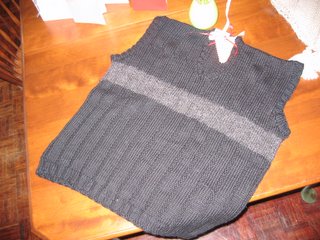
This is one reason why I enjoy designing. You know by now that knitting is the source of great pleasure for me, and providing someone with a project that they enjoy knitting and produces a good-looking garment -- well, that's very gratifying. I get a huge kick out of seeing someone else's spin on a garment I've designed: their color choices, slight alterations they make, and so on. Melissa used a cashmerino instead of Manos and you can see how the stitch pattern just pops with a less rustic, more uniformly-spun yarn. Cool.
I know some knitters who are very talented and creative and design lovely items, but who have no interest in creating patterns that other knitters can follow. To them, knitting is an opportunity to create one-of-a-kind garments, to wear a sweater or scarf or hat that no one else in the world can wear, an expression of their individuality, a way to reject some of the everyone-is-wearing-the-same-sweater-they-bought-at-Gap mentality of the masses. Knitting as anticonsumerism, if you will. I find this fascinating, although it's not something I personally am very concerned with. When I was a kid, I was painfully conscious of not fitting in, of not wearing the "right" brand of shoes or clothes, of not having a huge budget for clothes and not having parents who were very concerned with style. (To give you a feel for my parents' take on fashion, my dad freaked out the first time I wanted to wear blue jeans to school because he viewed blue jeans as something poor kids had to wear. You can imagine how this went over with the hippie sensibility that was en vogue at the time, this being the, ahem, 1970s.)
The knitting world is large, and I am lucky to encounter knitters of all ilks. Philosophical differences like these keep it interesting.

This is one reason why I enjoy designing. You know by now that knitting is the source of great pleasure for me, and providing someone with a project that they enjoy knitting and produces a good-looking garment -- well, that's very gratifying. I get a huge kick out of seeing someone else's spin on a garment I've designed: their color choices, slight alterations they make, and so on. Melissa used a cashmerino instead of Manos and you can see how the stitch pattern just pops with a less rustic, more uniformly-spun yarn. Cool.
I know some knitters who are very talented and creative and design lovely items, but who have no interest in creating patterns that other knitters can follow. To them, knitting is an opportunity to create one-of-a-kind garments, to wear a sweater or scarf or hat that no one else in the world can wear, an expression of their individuality, a way to reject some of the everyone-is-wearing-the-same-sweater-they-bought-at-Gap mentality of the masses. Knitting as anticonsumerism, if you will. I find this fascinating, although it's not something I personally am very concerned with. When I was a kid, I was painfully conscious of not fitting in, of not wearing the "right" brand of shoes or clothes, of not having a huge budget for clothes and not having parents who were very concerned with style. (To give you a feel for my parents' take on fashion, my dad freaked out the first time I wanted to wear blue jeans to school because he viewed blue jeans as something poor kids had to wear. You can imagine how this went over with the hippie sensibility that was en vogue at the time, this being the, ahem, 1970s.)
The knitting world is large, and I am lucky to encounter knitters of all ilks. Philosophical differences like these keep it interesting.
Tuesday, February 14, 2006
On the other hand, there's RYC
One of the goodies we got in at Rosie's over the weekend was a box full of RYC yarns and books, "RYC" being "Rowan Yarn Classics," a spin-off of Rowan. Given the direction of the lines, and given the way they keep shoving the word "classic" down our throats in every RYC book, I can't help but wonder if there was a conscious decision to shunt off knitters like me -- fill in your adjective here: over 35, more experienced knitters, less trendoid -- to the RYC line, leaving Rowan Magazine to be more trendy and hip. (Query whether we trust Rowan to make these kinds of fashion decisions, upon seeing the sorry state of the R2 line that debuted two years ago and landed with a thud.)
Regardless of the motivation, I was delighted by the new RYC books, which feature some really lovely and interesting designs. Certainly they are not as cutting edge as the stuff in the Rowan Magazine, but I quite like them. Classic Summer features the Cashcotton DK and 4-ply yarns. This is exactly the kind of Skippy vest my dear husband would love (maybe in some less fey colors):

Here's a lovely textured sweater for the gals:

And a cabled sweater that doesn't look baggy, boxy and unattractive:

Am I deluding myself? or does this baby NOT have dropped sleeves?
The Classic Beach book is devoted to the new Natural Silk Aran, which I definitely want to try soon (after the fifty-five other things I need to finish), and here's a cropped scoop-neck top that I think nicely straddles the line between looking contemporary without too outre to wear:

And a lacey eyelet/texture pullover:

And -- dare I say it? -- a clever shrug that is more than just a rectangle sewn together for sleeves?

This one's from the Classic Art book.
Again, the thoughts of my commenters are always welcome. I have to cut this post a little short today, as my daughter is suffering from an ear infection and therefore I am suffering from it, too.
Regardless of the motivation, I was delighted by the new RYC books, which feature some really lovely and interesting designs. Certainly they are not as cutting edge as the stuff in the Rowan Magazine, but I quite like them. Classic Summer features the Cashcotton DK and 4-ply yarns. This is exactly the kind of Skippy vest my dear husband would love (maybe in some less fey colors):

Here's a lovely textured sweater for the gals:

And a cabled sweater that doesn't look baggy, boxy and unattractive:

Am I deluding myself? or does this baby NOT have dropped sleeves?
The Classic Beach book is devoted to the new Natural Silk Aran, which I definitely want to try soon (after the fifty-five other things I need to finish), and here's a cropped scoop-neck top that I think nicely straddles the line between looking contemporary without too outre to wear:

And a lacey eyelet/texture pullover:

And -- dare I say it? -- a clever shrug that is more than just a rectangle sewn together for sleeves?

This one's from the Classic Art book.
Again, the thoughts of my commenters are always welcome. I have to cut this post a little short today, as my daughter is suffering from an ear infection and therefore I am suffering from it, too.
Monday, February 13, 2006
A fashion magazine or a knitting pattern book?
I had the chance to peruse Rowan No. 39 this weekend, the new spring/summer Rowan magazine that came out on February 1st. As a long-time fan of Rowan, I was struck by a couple of things. First of all, the composition of the patterns seems to be changing: more crochet (although since Rowan renamed the magazine "Knitting and Crochet" instead of just "Knitting," we shouldn't be surprised) [EDIT: Allow me to clarify that I don't think crochet is a bad thing; this is just an observation about the content of the magazine. I happen to be a crappy crocheter, so although I can admire crochet patterns (or at least some of them, like the ones by my pal Kathy Merrick), I can't do them. Apparently there are a lot of knitters who don't crochet.] and more dinky little accessories (like the armband, below).
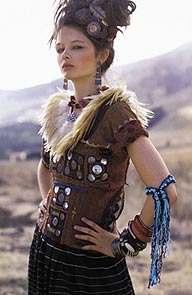
When a magazine says it has "over forty designs," and ten of them are one-offs like this, I feel cheated.
Of course, in fairness, there are some technically challenging and interesting designs in this issue.
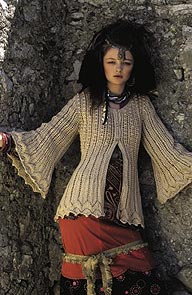
There's lace, textured stitches, beads and other embellishment, edgings and so on, and I appreciate that this isn't a magazine full of boxy, garter-stitch garments in chunky yarn. Let me not be accused of failing to give credit where credit is due.
The group of participating designers is starting to morph; we are still seeing some of the classic designers, like Kaffe Fassett and Brandon Mably, but a younger crowd of designers is more prominently featured these days. This is also not surprising: several Rowan designers, like Debbie Bliss and Kim Hargreaves and Louisa Harding, have left to start their own lines of yarn and publish designs under their own names. I have nothing against new designers, so long as their patterns are good. (Although I have to beseech the person who calls him- or herself "Kid Acne" to please, please change your name. Ick.)
But for me, what is most striking is the extent to which this particular Rowan feels trendy. I've always thought of Rowan Magazine as a publication to which one could frequently turn, even years later, and still find good patterns to make. And to some extent, I figured the world agreed; otherwise, why would old Rowans from years back sell so vigorously (and so expensively) on Ebay?
This year, however, more garments look like they're going to have a short shelf life. Crocheted shortie halter top?
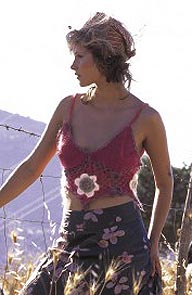
Apart from the question whether anyone will want to make these now, will anyone turn back to these in five years and think they've stood the test of time?
Another aspect of the magazine that is notable is the styling of the photo shoots. The layouts are so busy, the models so heavily layered with stuff (hats, belts, sweater over sweater) that it's very difficult to get a clear look at the garments.
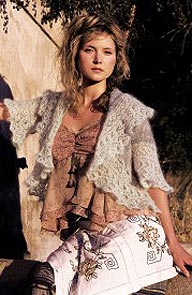
This is problematic from the standpoint of construction -- if you want guidance in creating a garment, it helps to be able to get a good clear look at a photo of it -- but also from the standpoint of selection. It's hard to decide whether you want to invest $100 or more in a sweater if you can't see it, or if the geegaws and makeup and styling are so busy
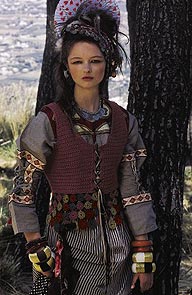
and distracting.
In this respect, Rowan 39 feels more like an issue of Vogue (regular Vogue, not Vogue Knitting). Fashion conscious, funky styling, showing us the edge of the fashion trend, but offering less in the way of guidance for the average Jane.
I'm looking forward to hearing the thoughts of my commenters on this one. I can't tell to what extent my own age is playing in to this: am I more likely to think hip, fashionable garments are too outre simply because I'm now on the other side of forty? And what is, or should be, the function of an industry leader like Rowan: to provide a look at fashion, like Vogue magazine does, or to provide clear blueprints for creating garments, seeing as it's a pattern magazine and all? Both? Is it even possible to do both?
Discuss.

When a magazine says it has "over forty designs," and ten of them are one-offs like this, I feel cheated.
Of course, in fairness, there are some technically challenging and interesting designs in this issue.

There's lace, textured stitches, beads and other embellishment, edgings and so on, and I appreciate that this isn't a magazine full of boxy, garter-stitch garments in chunky yarn. Let me not be accused of failing to give credit where credit is due.
The group of participating designers is starting to morph; we are still seeing some of the classic designers, like Kaffe Fassett and Brandon Mably, but a younger crowd of designers is more prominently featured these days. This is also not surprising: several Rowan designers, like Debbie Bliss and Kim Hargreaves and Louisa Harding, have left to start their own lines of yarn and publish designs under their own names. I have nothing against new designers, so long as their patterns are good. (Although I have to beseech the person who calls him- or herself "Kid Acne" to please, please change your name. Ick.)
But for me, what is most striking is the extent to which this particular Rowan feels trendy. I've always thought of Rowan Magazine as a publication to which one could frequently turn, even years later, and still find good patterns to make. And to some extent, I figured the world agreed; otherwise, why would old Rowans from years back sell so vigorously (and so expensively) on Ebay?
This year, however, more garments look like they're going to have a short shelf life. Crocheted shortie halter top?

Apart from the question whether anyone will want to make these now, will anyone turn back to these in five years and think they've stood the test of time?
Another aspect of the magazine that is notable is the styling of the photo shoots. The layouts are so busy, the models so heavily layered with stuff (hats, belts, sweater over sweater) that it's very difficult to get a clear look at the garments.

This is problematic from the standpoint of construction -- if you want guidance in creating a garment, it helps to be able to get a good clear look at a photo of it -- but also from the standpoint of selection. It's hard to decide whether you want to invest $100 or more in a sweater if you can't see it, or if the geegaws and makeup and styling are so busy

and distracting.
In this respect, Rowan 39 feels more like an issue of Vogue (regular Vogue, not Vogue Knitting). Fashion conscious, funky styling, showing us the edge of the fashion trend, but offering less in the way of guidance for the average Jane.
I'm looking forward to hearing the thoughts of my commenters on this one. I can't tell to what extent my own age is playing in to this: am I more likely to think hip, fashionable garments are too outre simply because I'm now on the other side of forty? And what is, or should be, the function of an industry leader like Rowan: to provide a look at fashion, like Vogue magazine does, or to provide clear blueprints for creating garments, seeing as it's a pattern magazine and all? Both? Is it even possible to do both?
Discuss.
Friday, February 10, 2006
Now this is interesting. Maybe.
You may have heard that Berroco, purveyor of all yarns shiny and glitzy, added Norah Gaughan to its design team. This doesn't seem like an obvious choice, since Norah Gaughan's designs tend to be big on texture and cables, while Berroco's tend to be big on novelty yarns, metallics and eyelash.
This spring, Berroco introduced Ultra Alpaca, which is a blend of 50% superfine alpaca and 50% wool, in 50 (yes, fifty!) shades, with good-sized hanks of 215 yds/100g. It knits at 5 stitches to the inch and Berroco promises good stitch definition. Note the "White Collection," a set of seven patterns in Ultra Alpaca that are most un-Berroco-like. No smarmy short-haired model is involved, and the patterns have lots of cables, eyelets and other stitch patterns. Here's a vest and scarf combo:

Now Berroco's going to have to do quite a bit to win me over. Any yarn company that expects its customers to create this

or is willing to do this
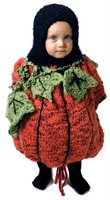
to an innocent child is on my permanent shit list.
But it is an interesting twist in a fluffy, furry, otherwise unremarkable line of yarns and designs. Does this signal an industry trend away from easy, and chunky, and over the top, to more organic, real yarns and more technically interesting styles?
Probably not, but a gal can dream, can't she?
This spring, Berroco introduced Ultra Alpaca, which is a blend of 50% superfine alpaca and 50% wool, in 50 (yes, fifty!) shades, with good-sized hanks of 215 yds/100g. It knits at 5 stitches to the inch and Berroco promises good stitch definition. Note the "White Collection," a set of seven patterns in Ultra Alpaca that are most un-Berroco-like. No smarmy short-haired model is involved, and the patterns have lots of cables, eyelets and other stitch patterns. Here's a vest and scarf combo:

Now Berroco's going to have to do quite a bit to win me over. Any yarn company that expects its customers to create this

or is willing to do this

to an innocent child is on my permanent shit list.
But it is an interesting twist in a fluffy, furry, otherwise unremarkable line of yarns and designs. Does this signal an industry trend away from easy, and chunky, and over the top, to more organic, real yarns and more technically interesting styles?
Probably not, but a gal can dream, can't she?
Thursday, February 09, 2006
The Gaywool Report
Single-mindedness is all very well in cows or baboons; in an animal claiming to belong to the same species as Shakespeare it is simply disgraceful.
-- Aldous Huxley
Okay, I'm a little obsessed
I ordered a few vials of Gaywool dye (okay, that's enough snickering from the Franklin peanut gallery; I didn't name the stuff) based on several recommendations I'd read. Gaywool is made by Louet, and comes in crystal form. Mordant is incorporated within the crystals so you don't have to add a separate substance to set the color; however, the directions do recommend heat-setting it by simmering on the stove. Best of all, I didn't notice any chemical odor during or after the dyeing process.
I began experimenting with the six different colors I purchased: two shades of pink, olive green, a forest green, indigo and plum. (In case you're wondering why those, I picked the pinks so I could compare them with the pinks I can get pretty readily using food coloring, and the rest because they are colors I can't get as easily with the food coloring.)
My first set of experiments were with the immersion method: you put the yarn in a metal bowl with water, then sprinkle the crystals over the top of the yarn, immersing the yarn in the water as the dye starts to dissolve. Then you let the yarn simmer over low heat for thirty minutes. I put a splash of vinegar in the water and let the hank soak for a few minutes before I started adding dye.
My first batch, using the two pinks and the plum, looked like this when I scattered crystals over it:

and after the crystals dissolved, it started to look like this:

Upon rinsing and drying, it came out like this (hank on the right):

My second batch used the two greens, same method. Once again, the ultimate color scheme was deeper than I had planned, at least in places. Here's what the dark green looks like knit up, in hat form:
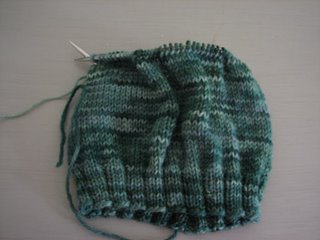
Lesson number one: Need to use less dye unless I want really deep shades, and be especially careful with deeper shades of dye -- a little goes a long way.
At this point I switched from aran-weight to fingering-weight yarn. Here's where it got frustrating. The sock yarn, using only the pink Gaywool shades, with a tiny dash of plum, came out like this:
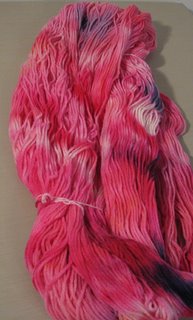
Hmmph.
Yes, the shades were lighter, but in spots the dye hit so lightly I got some nearly white patches. And although I was using two different shades of pink dye, I was disappointed that there wasn't more differentiation between them. I may overdye this in order to even out the splotchiness. Chalk this one up to experience.
More Food Coloring
Feeling cranky, I switched back to food coloring and Kool-Aid brand unsweetened drink mix (sorry, had a little trademark moment just then) and tried to replicate the rainbow skein I did early, using fingering weight yarn in the hope I could make a pair of socks.

Not quite as impressive than the first rainbow skein. The transitions between colors weren't as smooth and the colors didn't take as strongly. I tried a range of blues, and was less than thrilled with that. Same problems: splotchiness, unevenness, lots of dye running out in the rinse.
I gave it one last try: oranges and pinks, with a bigger splash of vinegar to try to get better color saturation. This, I like.
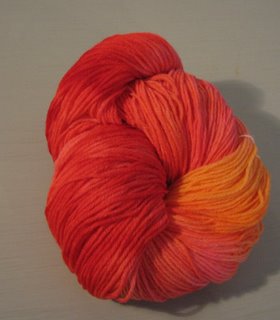
I have decided I don't like the fingering weight wool yarn (which was all the same brand, from an on-line retailer whose name rhymes with Snit-Licks). It didn't seem to take the colors as well as the thicker yarns I was using and much more dye washed out in the rinse. I suppose it's possible that the thinness of the yarn or some unknown factor (more lanolin? different bleaching process?) may be affecting my results. I'll have to find an alternate supply of fingering-weight, undyed wool that isn't shriekingly expensive and see if I get better results with different wool.
Back to Gaywool
The next day, I reverted back to thicker yarn and decided to play more with the Gaywool dyes. I used some worsted weight yarn (Paton's Classic Wool) and played with the concentration of dye in the water, keeping the overall shades on the lighter side. I love this periwinkle color, done with a relatively dilute concentration of the Indigo, and was pretty pleased with this skein (although it looks like it needs its hair combed).
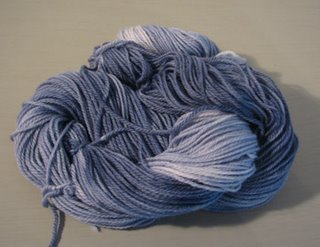
This yarn is definitely destined to become a cap for the Ship's Project, since it looks like camouflage -- unless it knits up so ugly that I wouldn't want to send it. I used the plastic wrap method, with each shade of green in swathes across the skein. I had a bit of bleeding together, but overall, not awful. The olive color isn't my favorite, but I guess it's all part of the experimental process.
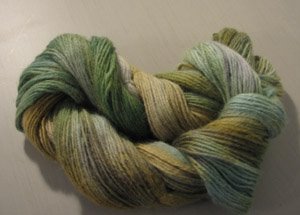
After playing a little more, I decided I like the Gaywool dyes and will definitely continue using them to expand my color ranges, although I will still use food coloring/Kool Aid too.
What do you do with all this yarn?
Daryl wants to know what I plan to do with all these skeins of yarn. I have to say that I will not be making any oven mitts. I finished the pink scarf for myself with one skein and will probably knit another scarf or two with some others. I owe mittens to each of my kids, and since the weather is getting chillier again in Philadelphia, started a quickie pair for James (yeah, like I need to start a new project).
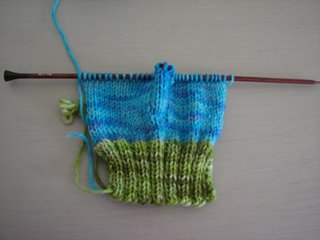
I'm going to make at least one pair of wristwarmers for myself, and the rest? I will probably do one or two hats for Afghans for Afghans and The Ship's Project, so long as the colors are appropriate and I can be sure some poor sailor won't take his hat off only to find green dye in a ring around his buzzcut. I may play around with the odds and ends to make a sweater for Grace using stripes and/or fair isle patterning, switching from bright color to bright color. Needless to say, I am also looking forward to Leigh Radford's book on One Skein Knitting, due out in April. And there's always socks.
-- Aldous Huxley
Okay, I'm a little obsessed
I ordered a few vials of Gaywool dye (okay, that's enough snickering from the Franklin peanut gallery; I didn't name the stuff) based on several recommendations I'd read. Gaywool is made by Louet, and comes in crystal form. Mordant is incorporated within the crystals so you don't have to add a separate substance to set the color; however, the directions do recommend heat-setting it by simmering on the stove. Best of all, I didn't notice any chemical odor during or after the dyeing process.
I began experimenting with the six different colors I purchased: two shades of pink, olive green, a forest green, indigo and plum. (In case you're wondering why those, I picked the pinks so I could compare them with the pinks I can get pretty readily using food coloring, and the rest because they are colors I can't get as easily with the food coloring.)
My first set of experiments were with the immersion method: you put the yarn in a metal bowl with water, then sprinkle the crystals over the top of the yarn, immersing the yarn in the water as the dye starts to dissolve. Then you let the yarn simmer over low heat for thirty minutes. I put a splash of vinegar in the water and let the hank soak for a few minutes before I started adding dye.
My first batch, using the two pinks and the plum, looked like this when I scattered crystals over it:

and after the crystals dissolved, it started to look like this:

Upon rinsing and drying, it came out like this (hank on the right):

My second batch used the two greens, same method. Once again, the ultimate color scheme was deeper than I had planned, at least in places. Here's what the dark green looks like knit up, in hat form:

Lesson number one: Need to use less dye unless I want really deep shades, and be especially careful with deeper shades of dye -- a little goes a long way.
At this point I switched from aran-weight to fingering-weight yarn. Here's where it got frustrating. The sock yarn, using only the pink Gaywool shades, with a tiny dash of plum, came out like this:

Hmmph.
Yes, the shades were lighter, but in spots the dye hit so lightly I got some nearly white patches. And although I was using two different shades of pink dye, I was disappointed that there wasn't more differentiation between them. I may overdye this in order to even out the splotchiness. Chalk this one up to experience.
More Food Coloring
Feeling cranky, I switched back to food coloring and Kool-Aid brand unsweetened drink mix (sorry, had a little trademark moment just then) and tried to replicate the rainbow skein I did early, using fingering weight yarn in the hope I could make a pair of socks.

Not quite as impressive than the first rainbow skein. The transitions between colors weren't as smooth and the colors didn't take as strongly. I tried a range of blues, and was less than thrilled with that. Same problems: splotchiness, unevenness, lots of dye running out in the rinse.
I gave it one last try: oranges and pinks, with a bigger splash of vinegar to try to get better color saturation. This, I like.

I have decided I don't like the fingering weight wool yarn (which was all the same brand, from an on-line retailer whose name rhymes with Snit-Licks). It didn't seem to take the colors as well as the thicker yarns I was using and much more dye washed out in the rinse. I suppose it's possible that the thinness of the yarn or some unknown factor (more lanolin? different bleaching process?) may be affecting my results. I'll have to find an alternate supply of fingering-weight, undyed wool that isn't shriekingly expensive and see if I get better results with different wool.
Back to Gaywool
The next day, I reverted back to thicker yarn and decided to play more with the Gaywool dyes. I used some worsted weight yarn (Paton's Classic Wool) and played with the concentration of dye in the water, keeping the overall shades on the lighter side. I love this periwinkle color, done with a relatively dilute concentration of the Indigo, and was pretty pleased with this skein (although it looks like it needs its hair combed).

This yarn is definitely destined to become a cap for the Ship's Project, since it looks like camouflage -- unless it knits up so ugly that I wouldn't want to send it. I used the plastic wrap method, with each shade of green in swathes across the skein. I had a bit of bleeding together, but overall, not awful. The olive color isn't my favorite, but I guess it's all part of the experimental process.

After playing a little more, I decided I like the Gaywool dyes and will definitely continue using them to expand my color ranges, although I will still use food coloring/Kool Aid too.
What do you do with all this yarn?
Daryl wants to know what I plan to do with all these skeins of yarn. I have to say that I will not be making any oven mitts. I finished the pink scarf for myself with one skein and will probably knit another scarf or two with some others. I owe mittens to each of my kids, and since the weather is getting chillier again in Philadelphia, started a quickie pair for James (yeah, like I need to start a new project).

I'm going to make at least one pair of wristwarmers for myself, and the rest? I will probably do one or two hats for Afghans for Afghans and The Ship's Project, so long as the colors are appropriate and I can be sure some poor sailor won't take his hat off only to find green dye in a ring around his buzzcut. I may play around with the odds and ends to make a sweater for Grace using stripes and/or fair isle patterning, switching from bright color to bright color. Needless to say, I am also looking forward to Leigh Radford's book on One Skein Knitting, due out in April. And there's always socks.
Tuesday, February 07, 2006
News Flash: Olympics Adopt Sta-Puf Marshmallow Man As Mascot

Who are these bizarro creatures? I can't help but think of a grainy 1950s commercial for, say, marshmallows, or some freaky Frosty-the-Snowman-meets-Teletubby bastard love child.
Meet Neve and Gliz, the official mascots of the upcoming Torino Olympics. From the official Olympic website:
Neve and Gliz are complementary characters: they represent the two elements without which the Olympic Winter Games cannot take place: snow and ice; and they personify the essence of winter sports: the harmony and elegance of the movements made in sport (with the fluid and rounded shapes of Neve) and the power and strength of the athletes (the angular and smooth shapes of Gliz).
Okay, commenters, have at it. Just remember, my American friends, that it was our country who produced Izzy:

Monday, February 06, 2006
If Interweave Knits were . . .
Sunday, February 05, 2006
On Not Getting Anything Done
True Story
One Saturday, about 2 or 3 years ago, my husband took the three kids over to see his parents. I had left shortly before him, anxious to enjoy a few hours of free time doing something glamorous, like grocery shopping without being pestered for Cocoa Pops, or returning vastly overdue library books. When I returned, looking forward to a quiet house and perhaps an hour of knitting, the front door was wide open.
I called my husband on the cell phone, and he swore he had closed and locked the door. So I then called the local police. A very polite officer showed up, and when I explained the situation, he assured me I had done the right thing, and he would be happy to go in with me until we confirmed there were no burglars hiding inside, waiting to steal my . . . yarn.
We entered the house, and the police officer's face blanched. "Do you want me to write up a report? What's missing?" he said.
I looked around. The house was in its normal state of chaos, toys and papers and clothes and yarn detritus thrown everywhere. Imagine my horror a split-second later when I realized he thought that thieves had ransacked the house looking for valuables.
Frustration
Today I am feeling frustrated. There are so many thing I want to do: projects to make, projects to design, yarns to try, halfway-done things to finish. Yet I feel I am just not making any progress. I find this eagerness to try so many things paralyzing. I start one thing, then stop and think I'll try another, then get anxious that I haven't finished the first, and so on. In the meantime, I have to stop a dozen times to get little people food, or help them in the bathroom, or find the keys that are right in front of my husband's face, or fold a load of laundry.
I now have a basket full of handdyed yarn I'm eager to try, and just don't know when I'll get to it. And the more I feel paralyzed by my lack of accomplishing anything, the more inertia takes hold, and I find I can't even sit down and finish knitting one complete row without getting up and down, and stopping and starting four other things.
Plus, my house is a mess.
One Saturday, about 2 or 3 years ago, my husband took the three kids over to see his parents. I had left shortly before him, anxious to enjoy a few hours of free time doing something glamorous, like grocery shopping without being pestered for Cocoa Pops, or returning vastly overdue library books. When I returned, looking forward to a quiet house and perhaps an hour of knitting, the front door was wide open.
I called my husband on the cell phone, and he swore he had closed and locked the door. So I then called the local police. A very polite officer showed up, and when I explained the situation, he assured me I had done the right thing, and he would be happy to go in with me until we confirmed there were no burglars hiding inside, waiting to steal my . . . yarn.
We entered the house, and the police officer's face blanched. "Do you want me to write up a report? What's missing?" he said.
I looked around. The house was in its normal state of chaos, toys and papers and clothes and yarn detritus thrown everywhere. Imagine my horror a split-second later when I realized he thought that thieves had ransacked the house looking for valuables.
Frustration
Today I am feeling frustrated. There are so many thing I want to do: projects to make, projects to design, yarns to try, halfway-done things to finish. Yet I feel I am just not making any progress. I find this eagerness to try so many things paralyzing. I start one thing, then stop and think I'll try another, then get anxious that I haven't finished the first, and so on. In the meantime, I have to stop a dozen times to get little people food, or help them in the bathroom, or find the keys that are right in front of my husband's face, or fold a load of laundry.
I now have a basket full of handdyed yarn I'm eager to try, and just don't know when I'll get to it. And the more I feel paralyzed by my lack of accomplishing anything, the more inertia takes hold, and I find I can't even sit down and finish knitting one complete row without getting up and down, and stopping and starting four other things.
Plus, my house is a mess.
Friday, February 03, 2006
A Bookworm's Progress: January
I'm an insatiable reader and read quickly and in large quantity. Just for the hell of it, I thought I would keep track of all the books I read in 2006. So here's January's tally:
1. The Well of Lost Plots, by Jasper Fforde. Hard to describe this book, but it's essentially a mystery set in an alternate version of our world, without being science fiction-y at all. If you are a bibliophile, take my word on this series; try the first book, The Eyre Affair, and see what you think.
2. Ordinary Heroes, by Scott Turow. A Christmas gift. Lots of plot, which makes the story fly so fast you don't have time to get irked at how improbable the whole thing is.
3. Self-Made Man, by Norah Vincent. Um, we already talked about this one.
4. The Historian, by Elizabeth Kostova. Another Christmas gift (from my crazy MIL even. She buys really good presents when she's manic). I'm only about one-third of the way through it, but it's a retelling of the Dracula story placed in contemporary times.
5. The Knitting Curmudgeon's book, by Marilyn Roberts. I've only read two chapters but let me just say they are kick-ass. You will want to buy this book. I'm really leery of stealing Marilyn's thunder so I won't say any more right now.
Believe it or not, this was kind of a slow month for me. I'll update this every month so that fellow book-lovers can compare notes and perhaps discover a new title or two they'd like to check out.
1. The Well of Lost Plots, by Jasper Fforde. Hard to describe this book, but it's essentially a mystery set in an alternate version of our world, without being science fiction-y at all. If you are a bibliophile, take my word on this series; try the first book, The Eyre Affair, and see what you think.
2. Ordinary Heroes, by Scott Turow. A Christmas gift. Lots of plot, which makes the story fly so fast you don't have time to get irked at how improbable the whole thing is.
3. Self-Made Man, by Norah Vincent. Um, we already talked about this one.
4. The Historian, by Elizabeth Kostova. Another Christmas gift (from my crazy MIL even. She buys really good presents when she's manic). I'm only about one-third of the way through it, but it's a retelling of the Dracula story placed in contemporary times.
5. The Knitting Curmudgeon's book, by Marilyn Roberts. I've only read two chapters but let me just say they are kick-ass. You will want to buy this book. I'm really leery of stealing Marilyn's thunder so I won't say any more right now.
Believe it or not, this was kind of a slow month for me. I'll update this every month so that fellow book-lovers can compare notes and perhaps discover a new title or two they'd like to check out.
Wednesday, February 01, 2006
Twinkle, Twinkle, Little Bowling Ball
For the Musical Purists
Okay, there's been some question raised about whether Mozart actually composed "Twinkle, Twinkle, Little Star," or if Haydn did. Legal eagle Mary W. sent a link which indicates that neither technically invented the tune, it being an old French folk ditty. [Er, Mary, should you be researching classical music or billing time that will translate into salary for my husband, a.k.a. The Man? Hmm?] However, both Haydn and Mozart apparently were inspired by the tune and incorporated it into their work.
Which leads me to wonder: if it is an old French folk tune, will M. Benoit Bourque cover it on his hurdy-gurdy?

We can only hope.
Not.
On Bowling and Etiquette
My kid had his 8th birthday party -- the one for the kids from his class at school -- on Sunday afternoon at the local bowling alley. Apart from the emotional trauma caused to Tom and me by a bunch of energetic eight-year-olds hyped up on cake running amok with heavy bowling balls in their hands, the party went very well. The kids are at such a sweet age, in many respects. They are still young and innocent enough to let loose and have fun together, and seeing that look of unbridled joy on my kid's face was wonderful. At the same time, you can see hints of things to come -- a blonde girl who swishes her long hair in a certain way, a particularly tall kid who is starting to get a little bit of that preteen, I-haven't-grown-into-my-body-yet awkwardness -- that tugs at your heartstrings.
And there are always the characters. The kid who shows up in some strange fleece hat that looks like it has Rasta braids and refuses to take it off. (His mother informs us that he won't ever take it off, and in fact she has had to purchase several identical hats in order to properly launder them.) Once I found out the kid didn't have lice that he was trying to hide, I was perfectly at ease with the idiosyncratic hat thing.
There was the already-impressed-with-herself girl with Ugg boots. When asked to change into bowling shoes, she thrust out her foot showily and whined, "But I don't know what shoe size I am!" "Look on the inside," I muttered.
It goes without saying that the kid who began the lovely game of blowing the party noisemakers all the way out his mouth and across the room in a spray of saliva was the one whose mother confided -- as she picked him up at the end of the party -- that he was recovering from strep throat.
The best part, however, has been the process of writing thank-you notes. Now unlike some famous bloggers, I am a pragmatist and don't really expect my kid to follow the intricacies of proper etiquette in writing thank-yous. I'm more concerned at this point with him understanding that if someone gives you a gift, you should thank them for it and if you don't open it in front of them, you need to write them a note.
I am letting him do them on the computer -- purists, please forgive me, I am weak -- and so we had some heated conversations about exactly why a thank-you note that looks like this

isn't suitable. Stickler that I am, I insist that a thank-you note must be legible to the recipient to count.
We then traversed the gaping crevasse of tact. Many an adult has failed to scale this great divide, and so it did not surprise me to see a note that looked like this:

How difficult these lessons are to teach!
Can you stand more dyeing talk?
I had to include these two photos of some other Kool-Aid/food coloring dye jobs. The attempt at a rainbow progression pleased me,
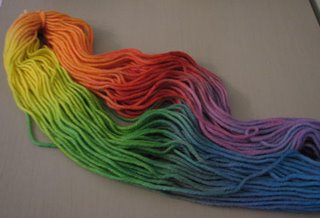
and the glorious array of colors on my humble drying rack (which is at least fifteen years old and still going strong) brought a badly-needed lift to some grey January days.

I will confess, dear readers, that I did, in fact, purchase some Gaywool dyes. After reading how easy it supposedly is to dye with them, I simply had to try them. I am in the process of figuring out how to best use them, and I'll report back in a few days on what I find out.
Okay, there's been some question raised about whether Mozart actually composed "Twinkle, Twinkle, Little Star," or if Haydn did. Legal eagle Mary W. sent a link which indicates that neither technically invented the tune, it being an old French folk ditty. [Er, Mary, should you be researching classical music or billing time that will translate into salary for my husband, a.k.a. The Man? Hmm?] However, both Haydn and Mozart apparently were inspired by the tune and incorporated it into their work.
Which leads me to wonder: if it is an old French folk tune, will M. Benoit Bourque cover it on his hurdy-gurdy?

We can only hope.
Not.
On Bowling and Etiquette
Of all the social rituals practiced in our civilization, the birthday party for young children is by far the most revolting. It must be endured, however, because it is a learning experience. ... It is the parents of the birthday child who learn most from the experience, sometimes such handy information as the replacement value of their property. The smart ones also learn quickly to find sites for the parties other than their homes.
-- J. Martin, Miss Manners' Guide to Excruciatingly Correct Behavior
My kid had his 8th birthday party -- the one for the kids from his class at school -- on Sunday afternoon at the local bowling alley. Apart from the emotional trauma caused to Tom and me by a bunch of energetic eight-year-olds hyped up on cake running amok with heavy bowling balls in their hands, the party went very well. The kids are at such a sweet age, in many respects. They are still young and innocent enough to let loose and have fun together, and seeing that look of unbridled joy on my kid's face was wonderful. At the same time, you can see hints of things to come -- a blonde girl who swishes her long hair in a certain way, a particularly tall kid who is starting to get a little bit of that preteen, I-haven't-grown-into-my-body-yet awkwardness -- that tugs at your heartstrings.
And there are always the characters. The kid who shows up in some strange fleece hat that looks like it has Rasta braids and refuses to take it off. (His mother informs us that he won't ever take it off, and in fact she has had to purchase several identical hats in order to properly launder them.) Once I found out the kid didn't have lice that he was trying to hide, I was perfectly at ease with the idiosyncratic hat thing.
There was the already-impressed-with-herself girl with Ugg boots. When asked to change into bowling shoes, she thrust out her foot showily and whined, "But I don't know what shoe size I am!" "Look on the inside," I muttered.
The behavior of children at a birthday party is not necessarily a result of their being badly brought up. Group dynamics nullify the results of discipline, and six well-behaved six-year-olds are the social equivalent of six hundred angry Bolsheviks.
-- Id.
It goes without saying that the kid who began the lovely game of blowing the party noisemakers all the way out his mouth and across the room in a spray of saliva was the one whose mother confided -- as she picked him up at the end of the party -- that he was recovering from strep throat.
Parents ... learn rehearsal techniques, as they instruct their children on that great social skill, faking pleasure, as it is applied to duplicate presents and wall-flower guests.
-- Id.
The best part, however, has been the process of writing thank-you notes. Now unlike some famous bloggers, I am a pragmatist and don't really expect my kid to follow the intricacies of proper etiquette in writing thank-yous. I'm more concerned at this point with him understanding that if someone gives you a gift, you should thank them for it and if you don't open it in front of them, you need to write them a note.
I am letting him do them on the computer -- purists, please forgive me, I am weak -- and so we had some heated conversations about exactly why a thank-you note that looks like this

isn't suitable. Stickler that I am, I insist that a thank-you note must be legible to the recipient to count.
We then traversed the gaping crevasse of tact. Many an adult has failed to scale this great divide, and so it did not surprise me to see a note that looked like this:

How difficult these lessons are to teach!
Can you stand more dyeing talk?
I had to include these two photos of some other Kool-Aid/food coloring dye jobs. The attempt at a rainbow progression pleased me,

and the glorious array of colors on my humble drying rack (which is at least fifteen years old and still going strong) brought a badly-needed lift to some grey January days.

I will confess, dear readers, that I did, in fact, purchase some Gaywool dyes. After reading how easy it supposedly is to dye with them, I simply had to try them. I am in the process of figuring out how to best use them, and I'll report back in a few days on what I find out.
Subscribe to:
Comments (Atom)

